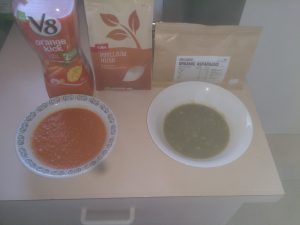There are at least four ways in which an eater may have less energy and nutrients after consuming a food: mechanical, chemical, physical and biological. The mechanical way is that chewing and other parts of digestion take energy, so if a food requires serious mastication and contains few calories, then more energy may be spent than absorbed. This has been claimed for raw celery.
Chemically, one food may react with another in a way that makes one or both of them less digestible. The less effective absorption reduces the nutrients obtained compared to not eating the second reactant. The chemical pathway to inefficient digestion may have multiple steps. For example, ascorbic acid leaches calcium from the body, and calcium is required for the absorption of vitamin D, so eating more citrus fruits may indirectly reduce one’s vitamin D levels.
When calculating the calorie content of food, indigestible fibre is subtracted from carbohydrates before adding up the energy obtained from carbohydrates, fats and proteins. However, if fibre reduces the absorption of calories (in addition to its known reduction of the absorption iron, zinc, magnesium, calcium and phosphorus), then the food’s bioavailable calorie content is less than that obtained by simply subtracting the fibre. To derive the correct calorie content, the fibre should then have negative weight in the calculation, not zero. This difference may explain why in Western countries, a high-fibre diet predicts better health in multiple dimensions in large prospective studies (Nurses’ Health Study, Framingham Heart Study), controlling for calorie intake, lifestyle and many other factors. If the calorie absorption is overestimated for people eating lots of fibre (because the calorie intake is larger than the absorption), then their predicted health based on the too high calorie estimate is worse than their actual health. This is because most people in Western countries overeat, so eating less improves health outcomes. If the predicted health is underestimated, then the high-fibre group looks unusually healthy, which is attributed to the beneficial effects of fibre, but may actually be due to absorbing fewer calories.
A food may chemically break down tissues, e.g. bromelain and papain, from fresh pineapple and papaya respectively, denature meat proteins, so cause mouth sores. Rebuilding the damaged tissue requires the energy and nutrients, the quantity of which may exceed that absorbed from the food.
Chemically causing diarrhea reduces the time that foods (including the laxative agent) spend in the gut, thus reduces nutrient absorption.
Stimulants like caffeine speed up metabolism and cause greater energy expenditure, but may give zero calories themselves, resulting in a net negative caloric balance.
Just like chemical damage, physical injury to the body necessitates spending calories and nutrients for tissue repair. For example, scratchy food (phytoliths, bran) may cause many microscopic wounds to the digestive tract.
Cold food requires the body to spend energy on heating, so if the calorie content is small, then the net energy obtained is is negative. Examples are ice cubes and cold water.
A food substance may physically partially block the absorption of another, for example a gelling agent (methylcellulose, psyllium husks) may turn a juice into a gel in the gut and thereby reduce its absorption. Based on my personal experience, psyllium husks gel liquid feces, thus effectively reducing diarrhea. Mixing psyllium husks with carrot juice and with asparagus powder  dissolved in water before consuming them during the same meal results in the excretion of separated faint orange and green gels somewhat distinct from the rest of the feces (photos available upon request, not posted to keep the blog family-friendly). This is suggestive evidence that the gelling agent both kept the juices from mixing in the gut and reduced the absorption of the colourful compounds by keeping the juice in the centre of the gel away from the intestinal wall.
dissolved in water before consuming them during the same meal results in the excretion of separated faint orange and green gels somewhat distinct from the rest of the feces (photos available upon request, not posted to keep the blog family-friendly). This is suggestive evidence that the gelling agent both kept the juices from mixing in the gut and reduced the absorption of the colourful compounds by keeping the juice in the centre of the gel away from the intestinal wall.
Biologically, a food may reduce the nutrients available to the organism by causing infection, the immune response to which requires energy and depletes the body’s reserves of various substances. Infection may lead to diarrhea, although the mechanism is chemical, namely the toxins excreted by the microbes. Infection with helminths (intestinal worms) that suck blood through the wall of the gut requires the replenishment of blood cells, which uses up calories, protein and iron.
If the food takes a long time to chew or is bulky, then chemical and electrical signals of satiation are sent from the gastrointestinal tract to the the appetite centre of the brain. These signals reduce the desire to eat, thus decrease calorie intake.
I’ve shared your web site in my social networks